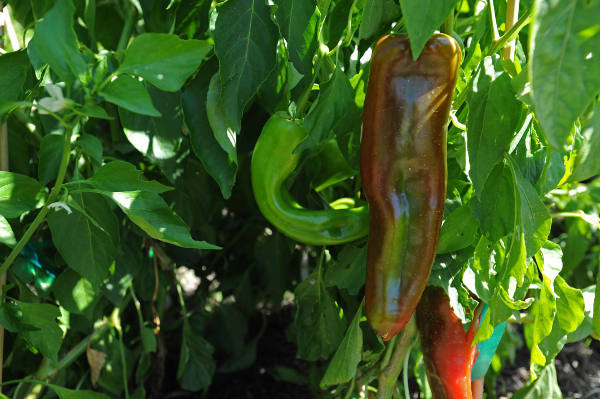
While red and green chili peppers still sit on top of the list as New Mexico's favorite food crop, commercial production fell sharply last year according to a USDA year-end crop production report and confirmed by the latest crop statistics from the New Mexico Department of Agriculture.
The official report indicates fewer acres of chili peppers planted and harvested in 2013, down about 16 percent from the previous year. USDA says 65,000 tons of New Mexico chili peppers were produced in 2013 compared to nearly 78,000 tons in 2012. Over a decade ago New Mexico chili pepper farmers were harvesting over 100,000 tons of green and red peppers each fall.
If you are enjoying reading this article, please check out Southwest Farm Press Daily and receive the latest news right to your inbox.
Stephanie Walker, a vegetable specialist at New Mexico State University, says while the drought played a major role in lower production numbers last year, chili pepper producers in the famous Hatch production area had to rely on pumping groundwater instead of having ample irrigation resources available from Elephant Butte Reservoir and the Rio Grande River.
The groundwater in the region is known for its high salinity and New Mexico State University extension officials say pepper plants simply do not thrive without adequate irrigation water from the river. They report high saline soils rob the plants of vitality and adversely affect overall production.
Walker says because of the ongoing drought and irrigation water shortages in the middle basin region, producers intentionally reduced acreage last year. Total New Mexico chili pepper acres declined from 10,000 acres in 2012 to just more than 9,000 acres last year.
But drought and water quality were not the only factors that contributed to production declines in 2013.
According to Hatch area producers, farm labor shortage also resulted in a smaller harvest last year, a problem that continues to plague agriculture across the Southwest.
In an interview with Southwest Farm Press in September, 2013, New Mexico Chile Association President and chili processor Dino Cervantes warned of agriculture hardships if Congress fails to adopt effective immigration laws that allow for an adequate farm worker program.
"Certain segments of agriculture are experiencing a serious threat over labor shortages, especially farms that depend on field workers to harvest a crop or move a crop to market," Cervantes said. "The principal cause behind the struggles our industry has experienced in recent years is the lack of available labor."
Cervantes says the state's famous chili pepper industry is one of the largest home grown industries in New Mexico, employing over 4,000 people. But as important as that may be for those who dedicate their time, money and property to chili pepper production, there is a greater reason to keep the industry fluid, and that is the sense of state pride that every New Mexican feels toward their favorite food.
High demand
Chili peppers in New Mexico are not just a culinary option, but an unspoken kitchen mandate.
Cervantes and other industry experts say demand for famous red and green New Mexico chili remains high and ongoing product campaigns keep the peppery twins in front of chili pepper fans. But even if the skies opened and the river fills to capacity, if adequate farm labor is not available to bring the crop in during the fall, then the industry will suffer the consequences.
As one Hatch farmer put it, "sooner or later the rains will return, but with no one to pick the chili, how can you market a product you can't deliver?"
Drought, a changing climate, soil salinity, water availability and farm labor have long made contributions to the successes and shortcomings of the New Mexico chili pepper industry. But industry experts say a shortage of farm labor in recent years has ranked as high a risk as water shortages.
Cervantes and Walker say university and industry researchers continue to look at mechanizing harvest operations and hope to develop a successful chili pepper picker. But outside of developing and implementing a mechanized harvest system, all hope for growth and vitality of the industry in New Mexico relies on finding solutions to farm labor issues.
New Mexico labor officials admit the state is facing a possible unskilled labor crisis. And it's not just the New Mexico chili pepper industry that is suffering. Other labor intensive agricultural operations include dairies and fruit and vegetable operations. They also point out that in addition to agriculture, many other types of industry in New Mexico require skilled and unskilled workers, including the hospitality, construction, cleaning, home health care, and food processing industries.
N.M. chili growers warned about virus
With the close of the 2013 season, USDA has valued the New Mexico's chili crop at less than $50 million, down about $16 million from 2012, and industry experts say the dual challenges of adequate water and farm labor seem to be no less troubling than last year.
But chili pepper producers around Hatch say they remain hopeful that the state's rich chili pepper tradition will continue in spite of the challenges it faces.
With one eye on Washington in hopes of a permanent farm labor policy and one eye on the sky in the hope of rain, chili pepper growers in New Mexico now begin the process of planning a crop for the new season.
Also of interest:
Farm workers needed to sustain heritage crop
Obama administration pressures House to pass immigration reform
About the Author(s)
You May Also Like




